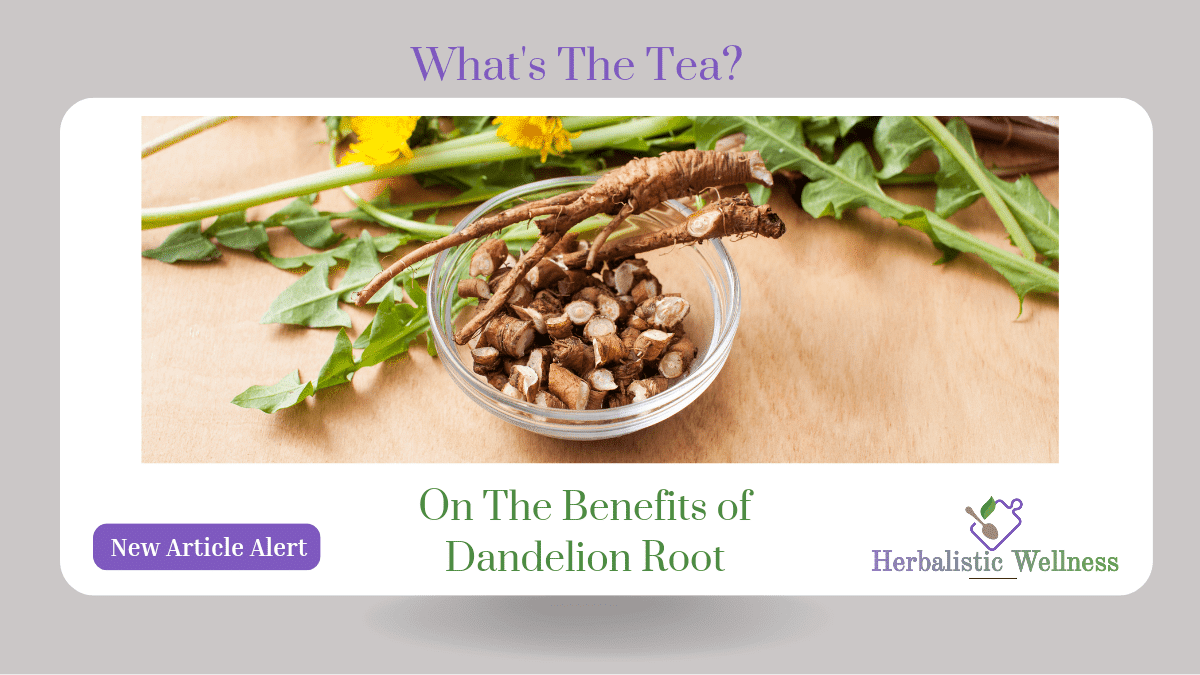Your cart is currently empty!

An Herbalist Point of View
Exploring the Potential Health Benefits of Dandelion Root: A Comprehensive Analysis
Unveiling the Marvels of Dandelion Root: A Comprehensive Exploration
Dandelion Root: A Hidden Gem of Nature’s Bounty
Often dismissed as a mere weed, dandelion (Taraxacum officinale) has quietly harbored a treasure trove of potential health benefits. While frequently considered a nuisance in lawns, dandelion might just hold the key to unlocking a multitude of health-promoting properties. In this comprehensive journey, we embark on an exploration of dandelion root, uncovering its purported health advantages, delving into potential risks, and shedding light on safe usage.

Why Dandelion Root?
1. A Delightfully Bitter Culinary Adventure: Dandelion’s Culinary Versatility
Dandelion proves to be more than just a plant; it’s a culinary delight. Its greens, with a slightly bitter and grassy flavor, can tantalize taste buds when savored either raw or cooked. This unassuming “weed” might pleasantly surprise your palate.
2. Echoes of Ancient Wisdom: Dandelion’s Role in Traditional Medicine
For centuries, dandelion has been an integral part of traditional Chinese medicine and various folk remedies. Its root, in particular, has been revered for its potential to address a wide array of health concerns. However, before delving deeper into the benefits of dandelion root, it’s important to examine the scientific foundation that underpins these age-old claims.
3. A Glimpse into Scientific Research: Unveiling Dandelion’s Secrets
While dandelion enjoys a rich legacy in traditional medicine, its validation through modern scientific research remains a work in progress. Current research is primarily based on test tube experiments and animal studies, leaving the realm of human benefits largely unexplored.
4. Managing Blood Sugar Levels: Dandelion’s Role in Type 2 Diabetes
The contemporary challenge of type 2 diabetes is closely linked to lifestyle factors such as obesity and poor diet. The benefits of Dandelion Root includes its compounds, most importantly chicoric acid and chlorogenic acid, show promise in counteracting the inflammation and glucose imbalances associated with diabetes. While studies in mice provide encouraging insights, the transition to human benefits is still pending.

5. Addressing Obesity: Dandelion’s Potential in Weight Management
Dandelion’s potential in tackling obesity holds promise, at least according to preliminary rodent studies. While studies in rats suggest a potential reduction in obesity, translating these findings to humans requires further investigation.
6. Cholesterol Champion: Dandelion’s Possible Cholesterol-Lowering Effect
Moreover, dandelion’s reputation extends to managing high cholesterol, as indicated by mouse studies. These studies suggest that dandelion leaf extract could modulate lipid levels, but its effects in humans are yet to be substantiated.
7. Guardian of Liver Health: Dandelion’s Role in Chronic Liver Disease
Dandelion’s association with promoting liver health has historical roots, and animal studies offer promising indications. However, the leap from animal models to meaningful human interventions necessitates thorough clinical trials.
8. Combatting High Blood Pressure: Dandelion’s Potential in Hypertension
With its natural diuretic properties, dandelion emerges as a potential aid in managing hypertension, which could subsequently reduce the risk of coronary artery disease. Yet, comprehensive human studies are required before these claims can be firmly established.
9. Heart’s Ally: Dandelion’s Contribution to Cardiovascular Health
Exploring dandelion’s potential in heart health reveals its diuretic attributes and antioxidant capabilities. Early signs from animal studies hint at heart-protective effects, but more extensive research involving humans is needed for conclusive evidence.

10. Easing Rheumatoid Arthritis: Dandelion’s Impact on Joint Health
Furthermore, dandelion unexpectedly joins the fight against rheumatoid arthritis, a condition characterized by autoimmune inflammation that damages joints over time. Taraxasterol, a dandelion component, shows promise in reducing inflammation and protecting against long-term joint damage, as demonstrated in studies on chemically induced arthritis in mice. The extent of this effect on human rheumatoid arthritis, however, remains uncertain.
11. Battling Cancer: Dandelion’s Potential as an Anti-Cancer Agent
Dandelion’s role in cancer prevention and treatment piques curiosity. Test tube studies have revealed intriguing possibilities, showcasing a cytotoxic effect akin to chemotherapy, minus the associated side effects. Despite these findings, evidence supporting the prevention or treatment of cancer in humans remains elusive.
12. Nurturing Radiant Skin: Dandelion’s Contribution to Skin Health
Dandelion’s potential in skin health takes us to a lab study involving chicken embryos, where it showed promise in healing skin damage caused by harmful UVB rays. Acting as an antioxidant, dandelion might hold the key to radiant skin, but further research is necessary to confirm its effects.
13. Aiding Digestion: Dandelion’s Potential Impact on Gut Health
Studies suggest that dandelion products may contribute to digestive health by promoting the growth of healthy gut bacteria through its prebiotic fibers and inulin content. While the precise mechanisms are still unclear, dandelion’s potential in alleviating constipation and enhancing nutrient absorption warrants further investigation.
14. Nourishing Lactation: Dandelion’s Alleged Role in Milk Production
Lastly, for nursing mothers, the benefits of dandelion root includes dandelion’s reputation as a galactagogue, potentially boosting milk supply, offers a glimmer of hope. However, the absence of concrete scientific evidence necessitates a cautious approach.

Navigating Risks and Interactions: A Balancing Act
As we traverse the path of dandelion exploration, it is imperative to acknowledge potential risks and interactions accompanying its use. While generally considered safe, excessive consumption of dandelion may trigger gastrointestinal discomfort, emphasizing the importance of moderation.
1. Risk of Allergic Reactions: Dandelion and Potential Allergens
Dandelion’s harmonious melody occasionally strikes a discordant note, particularly for individuals sensitized to certain plant families. Vigilance is crucial, as rare cases of life-threatening allergic reactions have been documented.
2. Interplay of Substances: Dandelion and Drug Interactions
In the symphony of health, dandelion may harmonize or clash with certain drugs. The intricate interplay between dandelion and various medications requires careful consideration, especially for those taking antibiotics, antidepressants, and other pharmaceuticals.

Guiding Your Journey: Using Dandelion Wisely
Incorporating dandelion into your wellness routine necessitates a thoughtful approach, adhering to recommended dosages and responsible sourcing. Whether savoring dandelion greens in a culinary masterpiece or integrating dandelion supplements into your regimen, maintaining prudence ensures a harmonious journey.
1. A Gastronomic Odyssey: Embracing Dandelion’s Culinary Charms
Embarking on a gastronomic odyssey involves savoring dandelion greens in delectable salads, soups, or sandwiches. The culinary world welcomes dandelion as a flavorful ingredient, promising a fusion of tastes and nutrients.
2. Navigating the Realm of Supplements: Selecting Dandelion Supplements
Dandelion supplements, available in various forms, merit a discerning eye. Opting for certified brands, endorsed by independent bodies, safeguards purity and quality, shielding against impurities.

Properly Preparing Dandelion Root as a Tea
Incorporating the remarkable benefits of dandelion root into your daily routine can be both flavorful and rewarding. To harness its potential in a delightful cup of tea, start by thoroughly cleaning and drying the fresh dandelion root. Chop the root into small pieces, approximately 1-2 inches in length. If your starting with dried cut and sifted root like you can get from Herbalistic Wellness then Boil water and pour it over the chopped dandelion root in a teapot or cup. Allow the mixture to steep for about 10-15 minutes, ensuring the infusion of its goodness. Strain the liquid, and if desired, add a touch of honey or lemon for added flavor.
In contrast, dandelion leaf tea offers a milder and slightly earthy taste. To create dandelion leaf tea, simply rinse and dry the leaves, then place them in a teapot or cup. Pour hot water over the leaves and let them steep for around 5-7 minutes, allowing their essence to infuse into the water. Strain and enjoy a refreshing and subtly aromatic cup of dandelion leaf tea.
By experimenting with dandelion root and leaf teas, you can not only explore their potential health benefits but also indulge in a variety of taste profiles. Embrace these simple yet effective methods to incorporate dandelion into your daily routine and embark on a journey of wellness and culinary discovery.
Summing Up the Journey: Convergence of Science and Tradition
Dandelion’s allure bridges the gap between ancient tradition and modern scientific inquiry, intertwining centuries-old wisdom with emerging insights. While its potential holds intrigue, a balanced perspective guides us as we embark on the path of dandelion exploration, exercising caution and a discerning spirit.
Amidst the mysteries of dandelion, we witness a symphony of possibilities, inviting us to navigate between tradition and innovation, skepticism and optimism, as we unravel the enigma and the benefits of dandelion root’s alleged health benefits.
Discover more from Herbalistic Wellness
Subscribe to get the latest posts sent to your email.



Leave a Reply